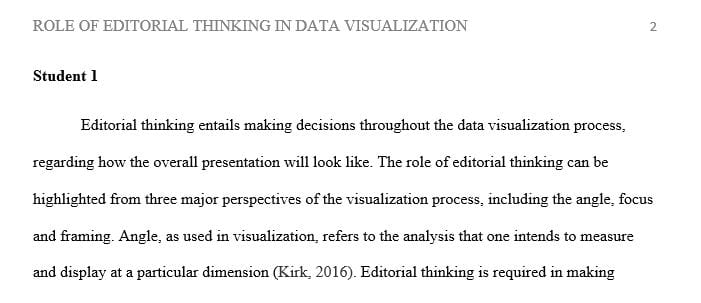Editorial thinking is about deciding which of the many viable perspectives offered by your data you will decide to focus on.
What role does editorial thinking play in data visualization? Why is it important or not important in your opinion? STUDENTS RESPONSE
Student #1: UPPAL
===================
Editorial thinking is about deciding which of the many viable perspectives offered by your data you will decide to focus on.
There are three particular perspectives to consider: angle, framing and focus.
Angle:
In visualisation, angle relates to the angle of analysis we intend to show: what are we measuring and by which dimension(s) are we breaking it down? Are we going to show how product sales have changed over time, or how sales look organised by regional hierarchically or how they compare on a map and over time? There are many different angles we could choose. We could also choose to show data from multiple different angles using several charts presented together.
Framing:
The next perspective to define about editorial thinking contributes to the refinement of the angles we have selected. A visualiser must demonstrate careful judgement about what to show, what not to show, and how to show it.
This is effectively a filtering decision concerned with which data to include and exclude:
All category values, or just a select few?
All quantitative values or just those over a certain threshold?
All data or just those between a defined start and end date period?
One of the key motives of framing is to remove unnecessary clutter – there is only so much that can be accommodated in a single view before it becomes too busy, too detailed, and too small in resolution.
Focus:
The third component of editorial thinking concerns is what you might choose to focus on.It is about emphasising what is more important in contrast to what is less important. Framing judgements is all about reducing clutter and not about reducing noise.
References:
Kirk, A.(2016). Data visualization: A handbook for data driven design. Los Angeles:SAGE.
==============================
Student #2 – KANURI
The key structure running is a data visualisation design process. By following this process you will be able to decrease the size of the challenge involved in making good decisions about your design solution. I say begin by learning about data visualisations “black and whites”, the rules, then start looking for the greys. It really then becomes quite a personal journey of developing your conviction..
The thing is, this world, especially the digital data visualization world, is changing rapidly: new technologies, new tools and frameworks are being developed constantly. So, you need to be able to adapt. But principles are much more timeless. If you know what you want to create, then using technology is just the means to create what you have in mind. If youre too fixed on one type of technology, you may be out of a job soon. So, keep learning new technologies, but more importantly, know your principles, as they will allow you to make the right decisions. Often, topics are disturbing or difficult; inherently ugly. But if they are illustrated elegantly there is a special sort of beauty in the truthful communication of something. Secondly, Kirk Goldsberry stresses that data visualization should ultimately be true to a phenomenon, rather than a technique or the format of data. This has had a huge impact on how I think about the creative process and its results.
A photo is never an objective reflection, but always an interpretation of reality. I see data visualization as sort of a new photojournalism – a highly editorial activity.
The capability to cope with the technological dimension is a key attribute of successful students: coding – more as a logic and a mindset than a technical task – is becoming a very important asset for designers who want to work in Data Visualization. It doesnt necessarily mean that you need to be able to code to find a job, but it helps a lot in the design process. The profile in the (near) future will be a hybrid one, mixing competences, skills and approaches currently separated into disciplinary silos.
Solution preview for the order on editorial thinking is about deciding which of the many viable perspectives offered by your data you will decide to focus on.
APA
368 words
